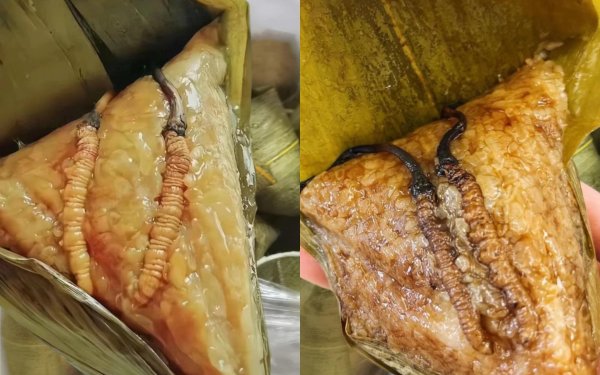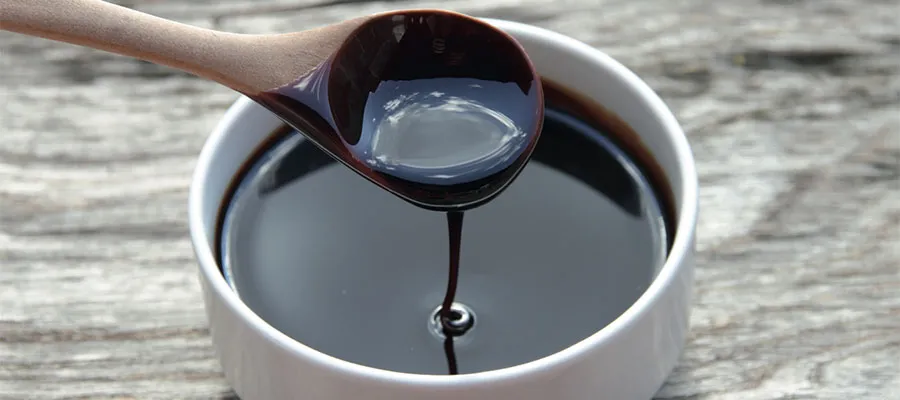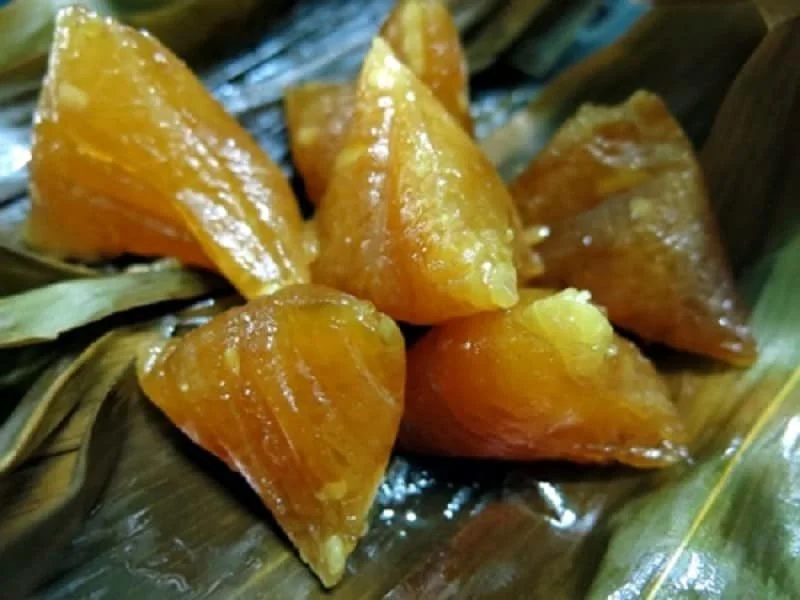Banh tro, also known as ash cake or gio cake, is a traditional Vietnamese delicacy with a fascinating history and unique flavor profile. Made from sticky rice soaked in ash water, this cake has a light, slightly chewy texture and a subtle aroma, which is enhanced when paired with sweet molasses. Banh tro is especially popular during the Đoan Ngọ Festival, celebrated on the fifth day of the fifth lunar month. Its simplicity, combined with its cultural significance, makes it a cherished treat in Vietnam. In this guide, we’ll dive into the ingredients, preparation steps, and cultural background of banh tro, exploring what makes it so special.
A Brief History of Banh Tro: From China to Vietnam

According to historical accounts, banh tro originally came from Guangdong, China. However, the Chinese version typically includes both sweet and savory fillings. When introduced to Vietnam, the recipe was adapted to suit local preferences, resulting in a simpler version that is traditionally made without any filling. In Vietnamese culture, banh tro is dipped in molasses to enhance its mild flavor, creating a perfect balance of sweetness and subtle bitterness. This adaptation has transformed bánh tro into a distinctly Vietnamese treat, reflecting the country’s culinary creativity and cultural adaptability.
Ingredients for Traditional Banh Tro (Ash Cake)
To make approximately 25 pieces of banh tro, you will need the following ingredients:
- 500 grams of yellow sticky rice – Yellow sticky rice gives the cake a nice color and consistency.
- 500ml of ash water – Ash water can be purchased at markets or online. It is traditionally made from plant ashes, such as rice straw or bamboo leaves, dissolved in water.
- Dong leaves (or bamboo/banana leaves) – Used for wrapping the cake, dong leaves add aroma and help retain the cake’s shape.
- Molasses – This sweet syrup is used as a dipping sauce for the cake.
- Salt – A pinch of salt helps to enhance the flavor of the rice.
- Banh tie string – Thin strings are used to tie the cakes securely during boiling.
Step-by-Step Guide to Making Banh Tro
Making bánh tro is a straightforward process, though it requires some patience due to the soaking and boiling times. Follow these steps to create the perfect ash cake.
Step 1: Soak the Sticky Rice
Start by thoroughly washing the glutinous rice to remove any impurities. Then, soak the rice in a mixture of 1 liter of water and 500ml of ash water. Let it soak for about 22 hours. Occasionally stir the rice gently and check for softness. When the rice grains are soft enough to break easily between your fingers, the soaking is complete.
After soaking, rinse the rice several times with clean water and drain it in a basket. Add a pinch of salt and mix gently to enhance the flavor of the rice. This salted rice will form the base of your bánh tro.
Step 2: Prepare and Wrap the Cake
Before wrapping the cakes, wash and dry the dong leaves. Trim off any thick stems or veins to prevent the leaves from breaking while wrapping. This step is crucial as intact leaves will keep the cake’s shape and prevent any leaks during boiling.
Lay a dong leaf flat on a clean surface and spread a thin layer of rice (about two fingers in thickness) on top of it. Fold the edges of the leaf together, then fold the ends to create a square or triangular shape. Use the banh tie string to secure the wrap, tying it tightly so the rice doesn’t spill out while cooking.
Step 3: Boil the Banh Tro
Place the wrapped cakes into a large pot, arranging them carefully so they don’t come undone. Fill the pot with enough water to cover the cakes completely. As the cakes are relatively small, they tend to float to the top. To ensure even cooking, place a heavy object on top of the cakes to keep them submerged.
Bring the water to a boil, then reduce the heat to maintain a steady simmer. Let the cakes boil for around 2 to 3 hours. During this time, check periodically to make sure the water level remains high enough. Add more boiling water if needed to keep the cakes fully submerged throughout the cooking process.
Step 4: Prepare the Molasses

While the cakes are boiling, prepare the molasses for dipping. If you don’t have store-bought molasses, you can easily make it at home. Heat a pan over low heat and add white sugar, allowing it to melt gradually. Simmer the sugar until it transforms into a thick, amber-colored syrup. Once it reaches the desired consistency, remove it from heat and let it cool.
The molasses adds a rich, sweet taste that complements the mild, slightly bitter flavor of bánh tro. It’s an essential part of the eating experience, bringing out the best qualities of the cake.
The Finished Product: How to Enjoy Banh Tro
Once the cakes have finished boiling, carefully remove them from the pot and let them cool on a clean surface. When cool enough to handle, unwrap the dong leaves to reveal the translucent, amber-colored cakes. The ash water used in soaking gives the cakes this distinct appearance, making them not only delicious but visually appealing as well.
Banh tro is traditionally enjoyed by dipping it in molasses. The cake’s chewy, soft texture, combined with the sweetness of molasses, creates a refreshing and balanced flavor. This delicacy is especially popular during hot weather, as its light taste and cooling effect provide a perfect escape from the summer heat.
The Cultural Significance of Banh Tro in Vietnam

Banh tro is more than just a tasty treat; it holds cultural significance in Vietnam, especially during the Đoan Ngọ Festival. This festival, which takes place on the fifth day of the fifth lunar month, is known as the “Festival for Killing Insects,” and it’s traditionally a time for cleansing and purifying the body. Bánh tro, with its simple ingredients and unique flavor, is believed to aid digestion, helping the body detoxify. Eating bánh tro during the festival is a way for people to connect with cultural heritage and honor traditional beliefs about health and wellness.
The Versatility and Popularity of Banh Tro
While banh tro is deeply rooted in tradition, its unique qualities make it a treat that people enjoy year-round. The cake’s simple, natural ingredients and mild flavor appeal to a wide range of palates. Today, bánh tro is commonly enjoyed as a snack or light dessert, bringing a taste of Vietnamese culture to both locals and visitors alike.
Banh tro’s versatility is also reflected in its adaptability to modern preferences. In some regions, the cake may be flavored with additional ingredients or paired with different dipping sauces to cater to contemporary tastes. Despite these variations, the traditional recipe remains widely popular, preserving the cultural and historical value of this beloved delicacy.
Conclusion: Embracing Tradition with Every Bite of Banh Tro
Banh tro, or ash cake, is a beautiful representation of Vietnamese culinary heritage. From its origins in China to its transformation into a uniquely Vietnamese treat, this simple yet meaningful cake has earned its place in the hearts of many. Making bánh tro may require patience, but the end result—a chewy, flavorful cake with a hint of bitterness, balanced perfectly by sweet molasses—is worth every effort. As you enjoy each bite, you’re not just tasting a traditional cake; you’re experiencing a part of Vietnam’s rich cultural tapestry, one that celebrates simplicity, health, and the beauty of time-honored flavors.


